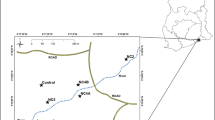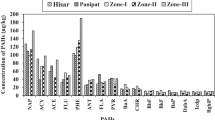Abstract
This study investigated the occurrence of 16 polycyclic aromatic hydrocarbons (PAHs) and 6 phthalic acid esters (PAEs) in 11 vegetable species collected from nine farms of the Pearl River Delta, South China. Twelve PAH compounds and all PAE compounds were detected by gas chromatography coupled with mass spectrometry (GC-MS) in vegetables. The total concentrations of PAHs (ΣPAHs) and PAEs (ΣPAEs) ranged from 7.0 to 5353 μg kg−1 dry weight (d.w.), with a mean value of 1173 μg kg−1 d.w., and from 0.073 to 11.2 mg kg−1 d.w., with a mean value of 3.2 mg kg−1 (d.w.), respectively. The highest levels of ΣPAHs and ΣPAEs were found in Brassica juncea and Brassica parachinensis, respectively. For the same vegetable, the bioconcentration factors (BCFs; the ratio of contaminant concentration in plant tissue to the soil concentration) of PAHs (between 0.0037 and 5.5) are generally higher than those of PAEs (between <0.0001 and 0.61). It was also noted that there were great variations of organic contaminant levels, BCFs, and benzo[a]pyrene equivalent concentrations, which depend on the various contaminants, sampling locations, and vegetable species. The occurrences of PAHs and PAEs in this study are compared with those in other studies and their sources are discussed.

Similar content being viewed by others
References
Agriculture Department of Guangdong Province (2005) General introduction to the agricultural of Guangdong Province. Available at: http://www.gd.agri.gov.cn/zwb/nygk/nyzb/P020050812519247189922.doc
Bishnoi NR, Mehta U, Pandit GG (2006) Quantification of polycyclic aromatic hydrocarbons in fruits and vegetables using high performance liquid chromatography. Indian J Chem Technol 13:30–35
Cai QY, Mo CH, Li YH, Zeng QY, Wang BG, Xiao KE, Li HQ, Xu GS (2005) Preliminary study of PAEs in soils from typical vegetable fields in areas of Guangzhou and Shenzhen, South China. Acta Ecol Sinica 25:283–288 (in Chinese, with English abstract)
Cai QY, Mo CH, Wu QT, Zeng QY (2006) Accumulation of phthalic acid esters in water spinach (Ipomoea aquatica) and in paddy soil. Bull Environ Contam Toxicol 77:411–418
Cai QY, Mo CH, Li YH, Zeng QY, Katsoyiannis A, Wu QT, Férard JF (2007a) Occurrence and assessment of polycyclic aromatic hydrocarbons in soils from vegetable fields of the Pearl River Delta, South China. Chemosphere 68:159–168
Cai QY, Mo CH, Wu QT, Zeng QY, Katsoyiannis A (2007b) Quantitative determination of organic priority pollutants in the composts of sewage sludge with rice straw by gas chromatography coupled with mass spectrometry. J Chromatogr A 1143:207–214
Cai QY, Mo CH, Wu QT, Katsoyiannis A, Zeng QY (2008a) Contamination of semivolatile organic chemicals (SVOCs) in the soil of China: a review. Sci Total Environ 389:209–224
Cai QY, Mo CH, Wu QT, Zeng QY (2008b) Polycyclic aromatic hydrocarbons and phthalic acid esters in the soil-radish (Raphanus sativus) system with sewage sludge and compost application. Bioresour Technol 99:1830–1836
Camargo MCR, Toledo MCF (2003) Polycyclic aromatic hydrocarbons in Brazilian vegetables and fruits. Food Control 14:49–53
Du Q, Shen L, Xiu L, Jerz G, Winterhalter P (2006) Di−2-ethylhexyl phthalate in the fruits of Benincasa hispida. Food Addit Contam 23:552–555
Falcó G, Bocio A, Llobet JM, Domingo JL (2005) Health risks of dietary intake of environmental pollutants by elite sportsmen and sportswomen. Food Chem Toxicol 43:1713–1721
Kazerouni N, Sinha R, Hsu CH, Greenberg A, Rothman N (2001) Analysis of 200 food items for benzo[a]pyrene and estimation of its intake in an epidemiologic study. Food Chem Toxicol 39:423–436
Kipopoulou AM, Manoli E, Samara C (1999) Bioconcentration of polycyclic aromatic hydrocarbons in vegetables grown in an industrial area. Environ Pollut 106:369–380
Kuo CY, Lee HS, Lai JH (2006) Emission of polycyclic aromatic hydrocarbons and lead during Chinese mid-autumn festival. Sci Total Environ 366:233–241
Li J, Zhang G, Li XD, Qi SH, Liu GQ, Peng XZ (2006) Source seasonality of polycyclic aromatic hydrocarbons (PAHs) in a subtropical city, Guangzhou, South China. Sci Total Environ 355:145–155
Li YT, Li FB, Chen JJ, Yang GY, Wan HF, Zhang TB, Zeng XD, Liu JM (2008) The concentrations, distribution and sources of PAHs in agricultural soils and vegetables from Shunde, Guangdong, China. Environ Monit Assess 139:61–76
Ma LL, Chu SG, Xu XB (2003) Organic contamination in the greenhouse soils from Beijing suburbs, China. J Environ Monit 5:786–790
Maskaoui K, Hu Z, Zhou JL, Han YL (2006) Levels of polycyclic aromatic hydrocarbons in some agricultural, industrial and urban areas along Xiamen coastal waters, China. J Environ Sci 18:318–322
Nadal M, Schuhmacher M, Domingo JL (2004) Levels of PAHs in soil and vegetation samples from Tarragona County, Spain. Environ Pollut 132:1–11
Phillips DH (1999) Polycyclic aromatic hydrocarbons in the diet. Mutat Res Gen Tox En 443:139–147
Shen F, Zhu LZ (2007) Concentration and distribution of PAHs in vegetables grown near an iron and steel industrial area. Environ Sci 28:699–702 (in Chinese with English abstract)
Simonich S, Hites R (1995) Organic pollutant accumulation in vegetation. Environ Sci Technol 29:2905–2914
Tao S, Cui YH, Xu FL, Li BG, Cao J, Liu WX, Schmitt G, Wang XJ, Shen WR, Qing BP Sun R (2004) Polycyclic aromatic hydrocarbons (PAHs) in agricultural soil and vegetables from Tianjin. Sci Total Environ 320:11–24
Tao S, Jiao XC, Chen SH, Xu FL, Li YJ, Liu FZ (2006) Uptake of vapor and particulate polycyclic aromatic hydrocarbons by cabbage. Environ Pollut 140:13–15
Thomas JA, Wienckowski DB, Gillies BA, Thomas MJ, Youkilis EJ (1986) Effects of phthalic acid esters (PAEs) on the neonate and aspects of teratogenic actions. Environ Health Perspect 65:243–248
Tsai PJ, Shih TS (2004) Assessing and predicting the exposure of PAHs and their carcinogenic potencies from vehicle engine exhausts to highway toll station workers. Atmos Environ 38:333–343
USEPA (1993) Provisional guidance for quantitative risk assessment of PAH. U.S. Environmental Protection Agency EPA/600/R-93/089
Voutsa D, Samara C (1998) Dietary intake of trace elements and polycyclic aromatic hydrocarbons via vegetables grown in an industrial Greek area. Sci Total Environ 218:203–216
Wennrich L, Popp P, Zeibig M (2002) Polycyclic aromatic hydrocarbon burden in fruit and vegetable species cultivated in allotments in an industrial area. Int J Environ Anal Chem 82:677–690
Yin MC, Su KH (1996) Investigation on risk of phthalate ester in drinking water and marketed foods. J Food Drug Anal 4:313–318
Zhang ZL, Hong HS, Zhou JL, Yu G (2004) Phase association of polycyclic aromatic hydrocarbons in the Minjiang River Estuary, China. Sci Total Environ 23:71–86
Zhong W, Wang M (2002) Some polycyclic aromatic hydrocarbons in vegetables from northern China. J Environ Sci Health A 37:287–296
Zhong-Guang Web (2008) Guideline establishment of meals for new residents—tower of balanced meals for Chinese residents. Available at: http://www.cnr.cn/nx/shtc/msjy/200803/t20080305_504725064.html. Accessed: 5 March 2008
Zohair A, Salim AB, Soyibo AA, Beck AJ (2006) Residues of polycyclic aromatic hydrocarbons (PAHs), polychlorinated biphenyls (PCBs) and organo-chlorine pesticides in organically-farmed vegetables. Chemosphere 63:541–553
Acknowledgments
This work was supported by the Natural Science Foundation of China (Nos. 40773062, 30671208, 30600372, and 30471007), Key Scientific Research Project of the Ministry of Education of China (No. 02112), the Natural Science Foundation of Guangdong Province (Nos. 021011, 036716, 043005970, and 07117909), and projects of the Department of Science & Technology of Guangdong (Nos. 01C21202, 03A20504, and 03C34505, 06B20601003), and the Research Foundation of the State Key Laboratory of Organic Geochemistry, Chinese Academy of Sciences. Thanks are also due to the personnel for supplying vegetable samples.
Author information
Authors and Affiliations
Corresponding author
Electronic supplementary material
Below is the link to the electronic supplementary material.
Rights and permissions
About this article
Cite this article
Mo, CH., Cai, QY., Tang, SR. et al. Polycyclic Aromatic Hydrocarbons and Phthalic Acid Esters in Vegetables from Nine Farms of the Pearl River Delta, South China. Arch Environ Contam Toxicol 56, 181–189 (2009). https://doi.org/10.1007/s00244-008-9177-7
Received:
Accepted:
Published:
Issue Date:
DOI: https://doi.org/10.1007/s00244-008-9177-7




